|

Monarch
Aaron Teitelbaum grew up in University City; he
graduated University City High School in 1992. It was while in high
school that Teitelbaum, in need of spending money, took a job at
Mark Erker's Catering St. Louis. He would move into a management
position with the company by the time he was nineteen.
Erker was my first
mentor, and he taught me about business, serving people and
doing what you do with care. He instilled in me how important it
is to be your best. That's an important thing for me, sometimes
to a fault.
Teitelbaum worked for Catering St. Louis for
eight years before leaving the company to go to college. Once there,
however, he realized that school wasn’t his thing. After a year of
floundering, he returned to St. Louis and again worked for Erker.
After three years, Erker encouraged Teitelbaum
to apply to culinary school. He was admitted to the Culinary
Institute of America in Hyde Park, New York. where he fell in love
with cooking, both inside the classroom and during his externships,
including a stint at Bobby Flay’s Mesa Grill.
After graduating from the Culinary Institute,
Teitelbaum wanted to learn about the front-of-the-house
side of the restaurant business. He applied for a job at Daniel,
Daniel Boulud's Upper East Side Manhattan restaurant.
I didn’t know
anything about it. I was big enough in my world in St. Louis
that I knew I was going to do a good job, but I didn’t know what
I was getting into there. They ended up hiring me as an
assistant general manager — a new position — but they had to
sneak me in under the chef's nose because I wasn’t French, and
they wanted me to prove why this non-French guy was running the
show in his house. For the first month, they hid me from him,
which was so bizarre because he lived above the restaurant.
Teitelbaum and Boulud grew close, with
Teitelbaum learning not only the operations and cooking sides of the
business, but also how important it was for a restaurant owner to be
a part of the community. But Teitelbaum's stay in the Big Apple
would come to an end.
After 9/11, New York
changed. I decided it was time to move on and move back to St.
Louis to open a restaurant.
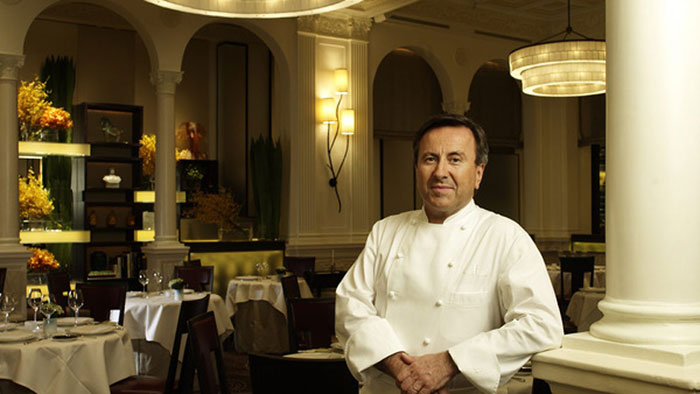 |
| Daniel
Boulud at Daniel |
Jeff Orbin and Aaron Teitelbaum were friends as
kids. Orbin grew up in the Florissant area and graduated Hazelwood
Central High in 1988.
Orbin had a background in design. He owned
Project 13, a graphic design firm in St. Louis. When he designed and
marketed the sushi bar Miso on Meramec, he became turned on to the
restaurant business.
That's when it got in
my blood. I called Aaron in New York and said, "Let's do this.
St. Louis is ripe for something like this, and if we don't do it
now, we never will."
Orbin and Teitelbaum formed a business
partnership based on Orbin’s sense that the city was ready, and on
Teitelbaum’s experience as a chef and restaurant manager. They
conceived of a place that fused food, wine and art. But they needed
a chef.
At the time, Brian Hale was executive chef at
SqWires Restaurant in Lafayette Square. His resume also included Al
Baker's and Harry's. Hale had found his way back to St. Louis after
spending time in Europe. His culinary career included a series of
apprenticeships in Milan, Paris and Brussels.
I just traveled and
found different chefs to work under. I’d go in and cut celery
and onions and carrots for eight hours a day for free. I'd gain
speed and precision at that level while I was soaking up as much
as I could from each chef. I took everything I learned and I
used it to create my own art.
Orbin stopped by SqWires for lunch because he'd
heard Hale was considering opening his own place. He
ordered Hale's signature
lobster mac-and-cheese.
It blew me away. It
was a cool restaurant with a different menu, and so I decided to
talk to Brian.
Orbin and Teitelbaum explained their restaurant
philosophy to Hale and he agreed to join them – before the restaurant
had a name or a space.
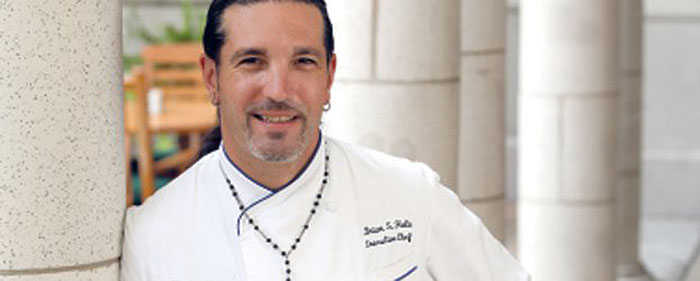 |
| Brian
Hale |
In 1996, Bob and Barbara Suberi had purchased a
building in the heart of Maplewood, at the corner of Manchester and
Sutton. It had originally housed a Katz Drug Store. They opened Bobby's in the space, a restaurant
they had originally operated as Bobby's Creole in University City.
By 2003, the Suberis had had enough of the
restaurant business. They closed their restaurant and leased the
space at 7401 Manchester to Aaron Teitelbaum and Jeff Orbin.
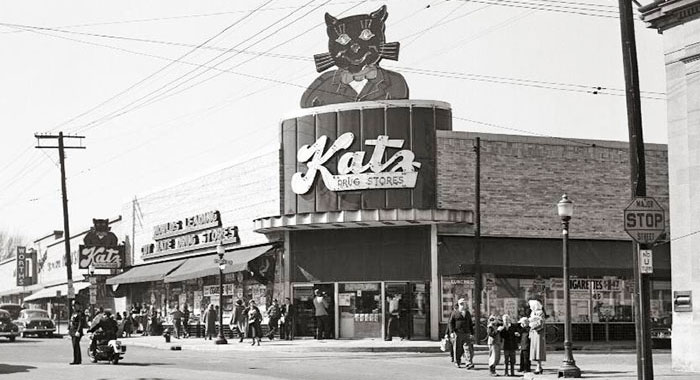 |
Katz
Drug Store, 7401 Manchester at Sutton, 1958
|
 |
|
Bobby's, 7401 Manchester, 1997 |
Teitelbaum and Orbin's new restaurant, which
they called Monarch, opened for business on June 4, 2003. Orbin had
designed and transformed the massive space into an innovative floor
plan. His imaginative use of expensive hardwoods, supple leathers,
chic fabrics and art glass made Monarch one of the most visually
interesting restaurants in St. Louis.
The large formal dining room was nearly
theatrical in design, with silk fabric overhead, draping across the
ceiling in billowing waves. Its adjacent glass-walled wine cellar,
visible from the dining room, accessed a secluded private dining
area.
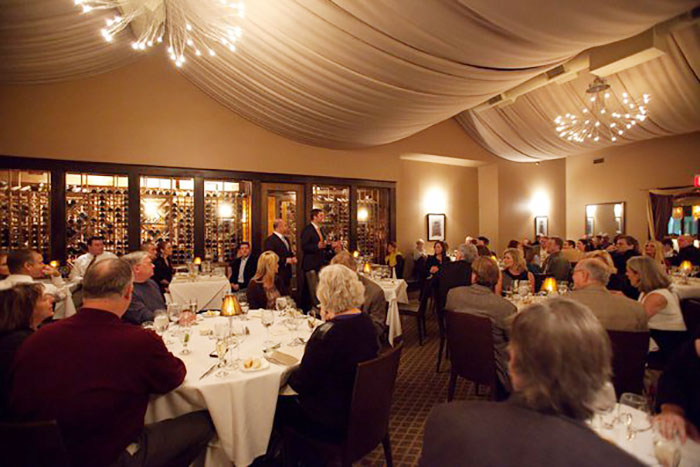 |
|
Monarch's Main Dinning Room and Glass-Walled Wine Cellar |
The bistro section, with its separate menu, was
a bright, narrow room along the east side of the building. It had a
more casual decor, with big casement windows that opened onto Sutton
Avenue.
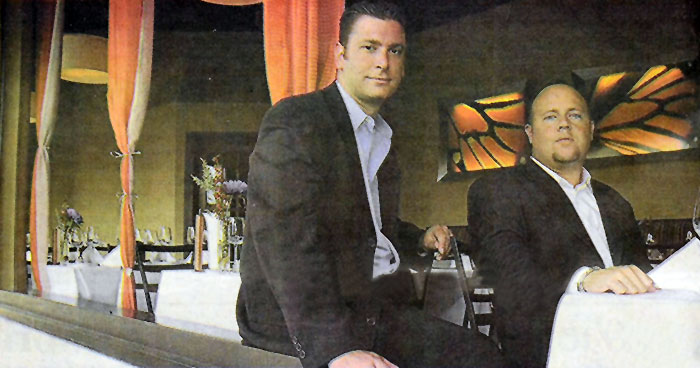 |
Aaron
Teitelbaum (left) and Jeff Orbin in Monarch's Bistro
St. Louis Jewish Light, Jun 16, 2004 |
A large bar was located off the
reception area. Off the bar area was an art gallery, which featured
monthly exhibits by local artists. Restaurant guests could wander
through the gallery after dinner or drinks, enjoying and often
purchasing pieces on display. Monarch prided itself on being the
only commission-free gallery in St. Louis.
Monarch also boasted a chef's table – a
glass-encased skybox for 10 people, suspended above the kitchen for
a bird’s-eye view of the mayhem. Hale would chat with skybox diners and
create a five-course meal to their liking.
I dance a little more
when someone is at the chef’s table. I get a little more
animated. Spoons fly. Flames rise.
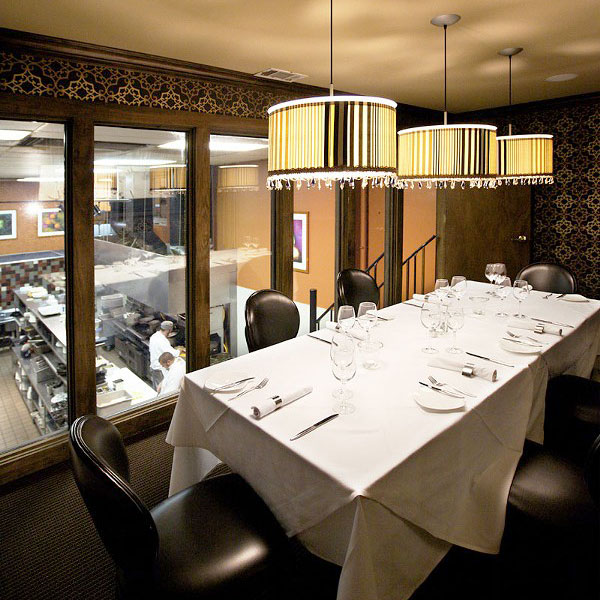 |
|
Monarch's Skybox |
Teitelbaum called Monarch's cuisine international. Hale's approach was haute cuisine with a French
twist.
Simply put, Monarch
is a food lover's paradise. Or, as one dining companion – a man
who plans his vacations around food and wine – phrased it: "This
is the closest thing St. Louis has to a New York City-caliber
restaurant."
Guests in the "fine dining room" begin their culinary journey
with an amuse-bouche, the French term for a gratis pre-appetizer
whose aim is to "amuse the mouth." This gift from the chef
titillates your palate while you soak in the dining room's
visual feast, and it also allows Hale to indulge his whimsy
while portending the meal to come. On one visit, our edible
trinket consisted of two asparagus spears drizzled with beurre
blanc, plus a couple of nut-stuffed dates.
Our appetites sufficiently whetted,
we ordered the crab martini, an exquisite appetizer of small
rounds of lump crab meat served in a chiffonade of radicchio and
endive, dressed with a vanilla-bean vinaigrette and presented in
an oversize martini glass. If food can be art, then Monarch is a
gallery. Hale
and crew's artistry continued with braised beef short ribs,
boneless and slowly cooked to tender beauty, then bathed with a
rich, concentrated cabernet reduction. Next to the beef sat a
truffle-celeriac-polenta tart, the earthy-tasting celeriac
(celery root) nicely complementing the richly flavored dish.
Chilean sea bass got its proper treatment, arriving perfectly
pan-seared – crisp exterior, succulent center – atop purple
Peruvian potatoes and crowned with a cucumber-onion-mango
relish. A final drizzle of a brothy leek reduction paired well
with the mouth-filling richness of the fish. The vegetable
accompaniment for all dishes comprised a colorful medley of
whole baby carrots and thin spears of broccolini and white
asparagus. And that brought the only quibble from our table:
With an abundant supply of fresh raw material available this
time of year, sending out the same standardized vegetable dish
with every entrée betrays a certain lack of enthusiasm in the
kitchen. Most
desserts are distinctive, although there is the regulation
molten chocolate cake. More satisfying is the crème caramel or
the fresh-made sorbet du jour, not to mention an adventuresome
mango-coconut-papaya bread pudding.
Michael Renner,
Riverfront Times, Aug 27, 2003
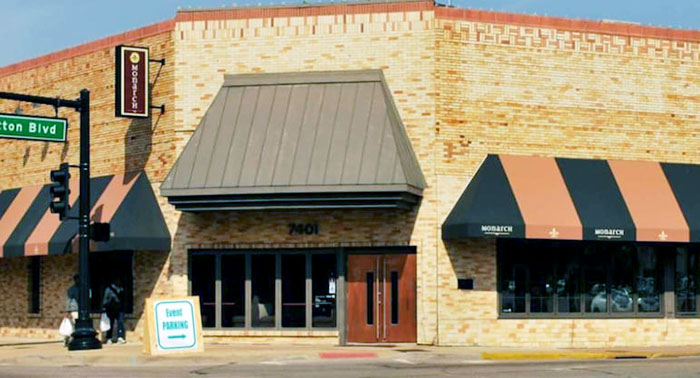 |
|
Monarch, 7401 Manchester |
In August of 2008 it was announced that Brian
Hale was stepping down as Monarch's executive chef, moving on to
take over dining operations at the Chase Park Plaza. By September,
Josh Galliano was manning the stoves.
Galliano, a Louisiana native, had trained at Le
Cordon Bleu in London. He worked at Michelin-starred restaurants
throughout Europe before returning to his home state to work at the
renown Commander's Palace in New Orleans. He then traveled up the
river to St. Louis, accepting the position as chef de cuisine at
Larry Forgione's An American Place.
Galliano's approach was different than Hale's
and he completely revamped Monarch's menu.
Better to say that
Galliano approaches every dish with restraint and respect. The
technique is always impressive, and the presentations are often
striking, but the ultimate focus is on the ingredients.
Consider the rib eye.
The steak arrives at the table in three thick slices, its
exterior seared to a perfect savory-sweet crisp, the interior, a
shade of red only just faded from purple. A gorgeous piece of
meat, it would be utterly satisfying on its own. Yet the sauce,
dense with mushrooms, provides an earthy backbeat, while pearl
onions contribute a mellow sweetness. Because this is a steak,
there must be potatoes, here in the form of potato-pecan
croquettes.
For all these
accompaniments, it is the rich flavor of the steak that lingers.
Likewise, braised short ribs, tender enough to be cut by the
mere mention of a fork, are a hearty winter pleasure. The meat
seems to dissolve into its sauce of red wine and roasted root
vegetables; a garnish of parsnip chips adds a dash of brightness
to all this savoriness.
Chicken dishes are
often a sop to the unadventurous diner, but Galliano's
garlic-crusted chicken breast is a winner — though here the
chicken really plays a supporting role to the garlic. Not only
is there the garlic crust, but also a purée of black garlic.
This is garlic that has ripened in the sun: It marries the
subtle flavor of roasted garlic to the tannic edge of raisins
and adds a striking grace note to this dish.
Sharing the plate
with the chicken breast is a hash of mushrooms and fingerling
potatoes, as well as roasted Brussels sprouts. This might not
sound especially exciting, but the dish as a whole strikes me as
Galliano's most impressive creation: Without calling attention
to itself — no clever names, no showy presentation — it takes
the humble pleasure of a roast-chicken dinner and presents it in
a new and interesting form.
Few area restaurants
expend much creativity on their seafood offerings. There is
shrimp, and there is salmon. Yet it is here that Galliano seems
to cut loose. Seared albacore tuna (not as luscious as yellowfin
or bluefin tuna, but more environmentally responsible) comes
with caramelized fennel and braised Jerusalem artichokes. This
is a study of sweetness: the clean flavor of the fish, the
fennel's strong licorice note and the sunchokes' mild, somewhat
nutty taste. Saffron-scented (and beautifully turned) potatoes
provide backbone, and an orange-balsamic jus ties everything
together with its touch of acidity.
The tuna is
immediately appealing, whereas the Missouri rainbow trout at
first seems too busy: There is a sweet potato-apple gratin,
housemade bacon, buttered cabbage and a grain-mustard jus. Yet
as the flavors combine, it makes sense, the combination of sweet
and smoky evoking an autumn campfire.
There were a few
disappointments. A trio of local pork, a special, lacked
variation in texture or flavor. Pork loin with a traditional
garlic and parsley persillade was only a shade different from
spiced ham with a hash of garbanzo beans and roasted garlic. The
latter came with an agrodolce sauce, yet both its sweet and sour
notes seemed muted. Braised pork belly was the standout, its
luscious texture given a striking contrast by its exterior,
which was seared to a brittle texture like the surface of a
crème brûlée.
The appetizer
selection is small. Ravioli filled with puréed winter squash are
lovely, with a warming combination of nutmeg and a sage beurre
blanc. Honey-roasted pork belly with cornbread croutons, baby
beets, gnudi (ravioli filling without the ravioli) and basil
cream is very good, if almost too rich to be an appetizer. For
all those components, it needed a steak of acidity or spice to
cut through the heaviness. Similarly, the lamb pâté on the
housemade charcuterie plate lacked a distinctive flavor. On the
other hand, the thinly sliced bresaola burst with flavor.
Galliano also created
the desserts, and the selection, though brief, is striking. I
opted for the dreamsicle semifreddo, which perfectly captured
the flavor of that childhood treat. To complement its
orange-vanilla flavor, Galliano serves it with a sort of oatmeal
cookie, sage ice cream and a coriander-spiced tuile. A burst of
summer freshness amid the depths of a very cold winter.
Ian Froeb,
Riverfront Times, Jan 21, 2009
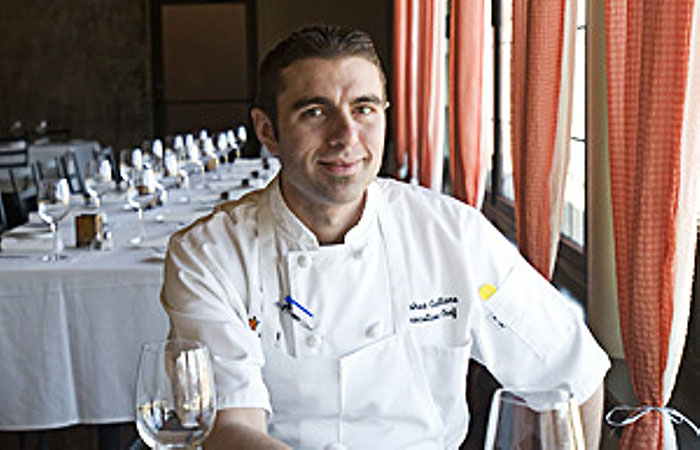 |
Josh
Galliano in Monarch's Bistro
Riverfront Times, Jan 21, 2009 |
In 2010, Monarch closed
from June 1 until August 2 to renovate its space and design a
new menu.
The main dining room
changed its seating arrangement and updated its décor, with soft
bronze colors, black chairs, eggshell-white linens, buttery
lighting and clouds of coppery butterflies twinkling overhead.
The bar and bistro
underwent the most significant changes, with the main entrance
more open, flowing naturally into the bar on one side and the
bistro on the other.
 |
Monarch's Renovated Main Dining Room
|
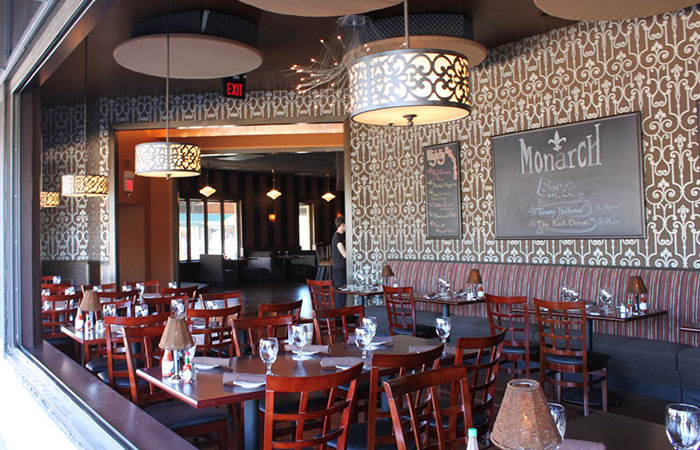 |
|
Monarch's Renovated Bistro |
A new southern-style menu
was offered in the bistro and bar areas; the menu remained
essentially unchanged in the main dining room. Inspired by
Galliano's Louisiana upbringing and his work in New Orleans, the
new menu included such items as crawfish etouffee, hush puppies,
shrimp and grits, sweet potato crusted flounder, "signature" po-boys,
beignets and homemade root beer floats.
About half the
menu is devoted to "Snacks," small plates and po' boy
sandwiches. These can be fun. "Crawfish Bread" is like an
upscale Hot Pocket, with a blend of crawfish étouffée and
cheese baked inside a thin shell of dough. The "miniature"
Natchitoches meat pies are actually quite plump with a spicy
ground-beef mixture. The "Surf n' Turf" po' boy overflows
with tender, shredded roast beef and crisp fried shrimp.
It's a knife-and-fork sandwich. A "special" sauce and
horseradish ketchup give it extra savor and a mild kick. (In
a move that is either cute or a cost saver — or both — the
po' boys are served with a bag of Old Vienna potato chips on
the side.)
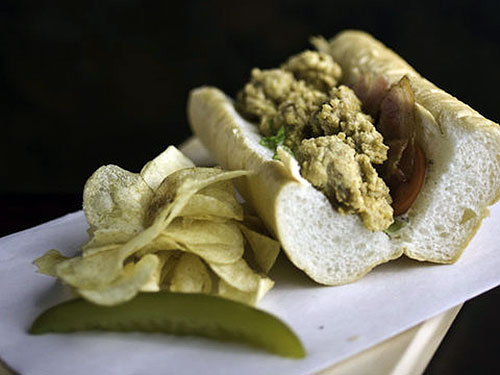 |
|
"Surf n' Turf" Po'
Boy |
Only one of the
small dishes sported the grace note St. Louisans have come
to expect from Galliano's cooking. At first glance the hush
puppies are conventional cornmeal fritters, with jalapeño
providing a touch of heat. Yet Galliano adds a little
bacalao (salt cod) to give it a subtle funk and then,
crucially, serves the hush puppies in a burnt-lemon sauce.
This is wonderfully complex: tart, toasty-sweet, with a
lingering, mouth-filling richness.
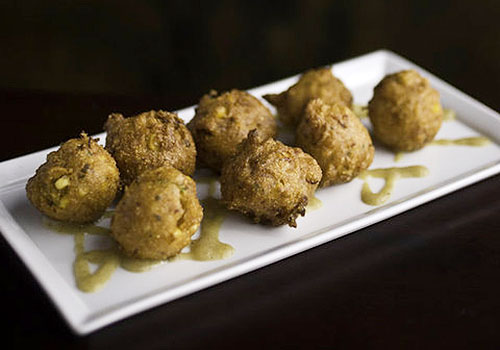 |
|
Hush Puppies |
Entrées include
one of the better catfish dishes I've had, a playful
Southern take on the great Daniel Boulud's sea bass wrapped
in thin slices of potato. Here the fish is wrapped in
shredded sweet potato and then sautéed. The browned potato
adds depth of flavor to the mild fish and also keeps its
flesh tender. Served in a sage beurre blanc with roasted
mushrooms and braised red cabbage, it's the sort of dish I'd
expect to find on Galliano's dining-room menu: a classic,
elevated by his personal touch.
The Creole-spiced
butcher (or hanger) steak — a naturally flavorful cut of
meat served over mashed potatoes — might be the menu's most
bistro-esque dish. The Creole spicing is gentle. What makes
the dish work is the marchand de vin. The brightly flavored
sauce, made here with Tasso ham, cuts through the steak's
richness and adds flair to an otherwise straightforward
preparation.
Ian Froeb,
Riverfront Times, Oct 27, 2010
* *
* * *
Despite its facelift and
culinary makeover, Monarch announced it was closing its doors on
March 11, 2012. Orbin said that the restaurant’s size, the
economy and competition from restaurants participating in
discount-dining offers had contributed to the decision.
The local dining
scene now just isn’t large enough to support a
10,000-squarefoot restaurant anymore. In a perfect world, we
would have found an 80-seat restaurant that we could
purchase, build out and have running before we closed. We
wanted to go out while we were on top and still be able to
do this thing gracefully with severance packages and paying
all our vendors.
The lights went out with a
final press release.
We couldn't be
more proud of the Monarch team for countless hours and
continued commitment in building such an impressive brand,
not to mention the numerous accolades and awards that we
have been honored to receive both locally as well as
nationally. This has been one of the hardest business
decisions for us to make.
 |
| Monarch,
7401 Manchester |
Copyright © 2021 LostTables.com
Lost TablesTM
is a trademark of LostTables.com. All rights reserved. |















